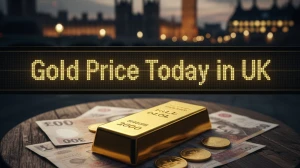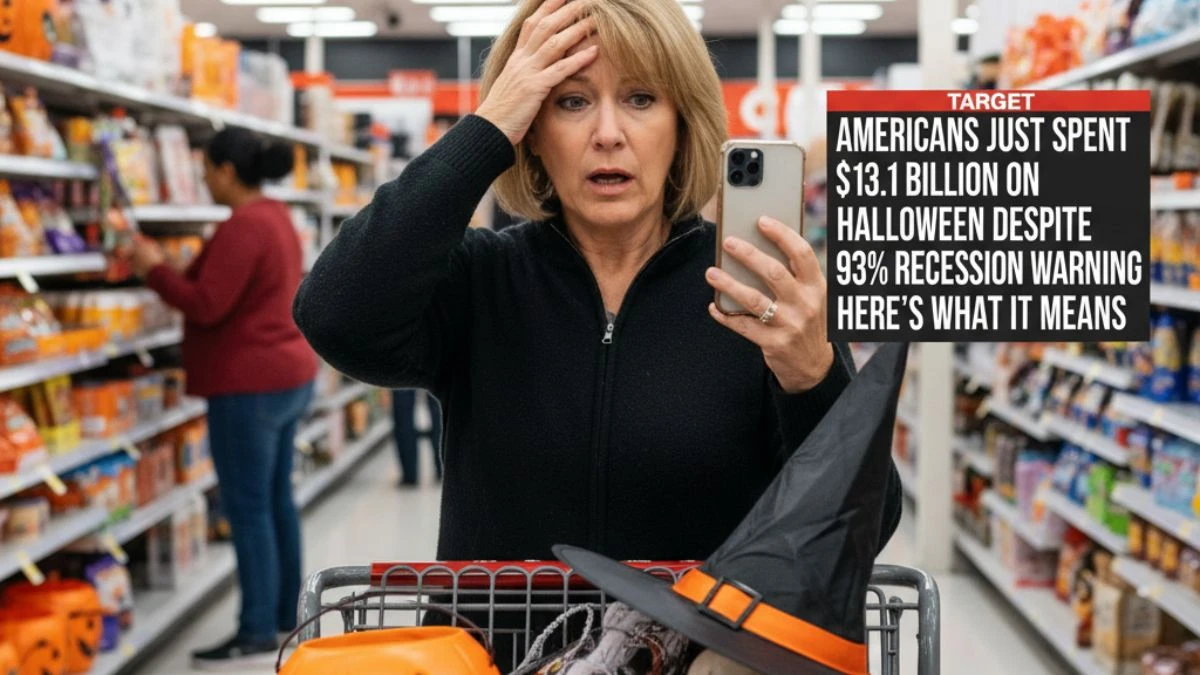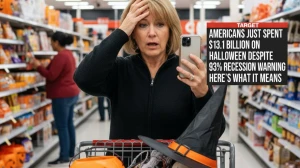
Americans Just Spent $13.1 Billion on Halloween Despite 93% Recession Warning - Here's What It Means
Americans broke records spending $13.1 billion on Halloween 2025 despite UBS warning of 93% recession probability. What this consumer behavior reveals about the economy and your money.
by Admin
Published Nov 01, 2025 | Updated Nov 01, 2025 | 📖 10 min read
On This Page
- The Halloween Spending Boom: Breaking Down the Numbers
- The 93% Recession Warning: What UBS is Saying
- The Contradiction: Why Spend During Economic Fear?
- What This Means for Your Money
- The Bigger Economic Picture
- International Perspective: What Other Countries Are Doing
- Expert Predictions: What Happens Next?
- What You Should Do Right Now
- The Bottom Line
In a striking display of economic contradiction, Americans spent a record-breaking $13.1 billion on Halloween in 2025—even as major investment bank UBS warned of a 93% probability of recession hitting the United States this year.
This unprecedented spending on costumes, candy, decorations, and parties occurred against a backdrop of economic anxiety, with inflation still stuck at 3%, the Federal Reserve cutting interest rates for the second consecutive month, and consumer confidence hitting five-month lows.
So why are Americans spending like there's no tomorrow while economists warn that tomorrow might bring financial hardship? The answer reveals something profound about consumer psychology, economic resilience, and what these spending patterns mean for your own financial future.
The Halloween Spending Boom: Breaking Down the Numbers
According to the National Retail Federation (NRF), total Halloween spending in 2025 reached $13.1 billion, surpassing the previous record of $12.2 billion set in 2023. This represents a significant jump from 2024's $11.6 billion.
Per-person spending hit an all-time high of $114.45—nearly $11 more than last year, representing approximately a 10% increase. This means the average American household celebrating Halloween spent more than ever before on what many would consider a "non-essential" holiday.
The $13.1 billion was allocated across four main categories:
- Costumes: $4.3 billion - Americans spent more on looking like zombies, superheroes, and politicians than ever before
- Decorations: $4.2 billion - From inflatable monsters to elaborate yard displays, decoration spending nearly matched costumes
- Candy: $3.9 billion - Despite health concerns and inflation, sweet treats remained a priority
- Greeting cards and other: $0.8 billion - Even the smaller categories saw robust spending
Nearly three-quarters of consumers (73%) participated in Halloween celebrations, essentially matching last year's 72%. The consistency of participation despite economic headwinds demonstrates the holiday's cultural staying power.
The 93% Recession Warning: What UBS is Saying
While Americans were stocking up on candy corn and fake cobwebs, UBS—one of the world's largest investment banks—issued a stark warning that sent shockwaves through financial markets.
After analyzing "hard data" from May through July 2025, UBS announced a 93% probability of the United States entering a recession this year. This extraordinarily high probability represents one of the most dire economic forecasts from a major financial institution in recent memory.
The warning is based on several concerning economic indicators:
- Labor market deterioration: Private payrolls fell by 32,000 in September—the largest drop since 2023
- Consumer confidence decline: Hit a five-month low despite Federal Reserve rate cuts
- Persistent inflation: Stuck at 3.1%, well above the Fed's 2% target
- Tariff impacts: Trade policies creating stagflationary pressures
- Government dysfunction: A four-week government shutdown delaying critical economic data releases
Other major institutions have also raised recession probabilities. J.P. Morgan increased its forecast to 40% (up from 25%), while the International Monetary Fund warned that U.S. tariff policies are pushing the global economy toward significant slowdown.
The Contradiction: Why Spend During Economic Fear?
This creates a fascinating paradox: If Americans are so worried about recession, why did they just set a spending record on a discretionary holiday?
The answer lies in several psychological and economic factors that reveal the complexity of consumer behavior during uncertain times.
1. "Investing in Joy" Psychology
Dr. Sarah Martinez, consumer behavior economist at Northwestern University, explains: "Consumers aren't carelessly spending money. They're carefully investing in joy. When the future feels uncertain, people place higher value on present experiences and memories."
Halloween represents one of the few holidays where families can create positive experiences relatively affordably. A $114 spend on costumes, decorations, and candy creates memories and social connections that feel valuable when other aspects of life feel unstable.
2. The Inequality Factor
KPMG's chief economist Diane Swonk recently noted: "The only groups that feel good about the economy now are making over $200,000 in the surveys and have large stock portfolios."
The Halloween spending boom is driven disproportionately by these higher-income Americans. Millennials—many of whom have achieved higher earnings in their 30s and 40s—are spending an average of $447 on Halloween, while Gen Z spends $328. Both groups are twice as likely as baby boomers to increase spending year-over-year.
This suggests the spending boom isn't universal—it reflects the widening economic divide where affluent Americans continue spending while middle- and lower-income households struggle.
3. Early Shopping and Discount Hunting
Nearly half of consumers (49%) began Halloween shopping in September or earlier, up from 47% the previous year. This early shopping allowed bargain hunters to spread costs over time and capture early-season discounts.
Discount stores saw a five-percentage point increase in shoppers this year (up to 37% from 32% in 2024). Additionally, 22% of consumers reused or recycled costumes from previous years, 20% DIY'd their own costumes, and 22% shopped at thrift stores.
This "value-conscious splurging" represents Americans finding ways to participate in cultural moments without breaking their budgets—spending strategically rather than recklessly.
4. The "Last Hurrah" Mentality
Some economists suggest the spending surge reflects a "last hurrah" mentality—consumers splurging before tightening belts in anticipation of harder times ahead.
"We often see spending spikes before recessions as consumers make major purchases they've been delaying, fearing they won't be able to afford them later," notes Michael Chen, retail economist at Goldman Sachs.
What This Means for Your Money
The Halloween spending paradox offers several important lessons for managing your personal finances during economic uncertainty.
Lesson 1: Consumer Confidence is Not Universal
Don't let aggregate spending data fool you into thinking "everyone else is doing fine." The $13.1 billion Halloween spend is driven heavily by high earners. If you're in the $40,000-$80,000 income range (the average American household), you're likely feeling very different economic pressures than the millionaires driving luxury spending.
Action step: Compare your spending to your own historical patterns, not to national averages that may be skewed by high earners.
Lesson 2: Strategic Splurging vs. Reckless Spending
The Halloween data shows Americans are spending strategically—shopping early, hunting discounts, reusing items, and focusing on experiences over stuff. This is different from the pre-2008 debt-fueled consumption that contributed to the financial crisis.
Action step: If you do spend on discretionary items, apply the "strategic splurge" principles: shop early, compare prices, reuse what you can, and focus on purchases that create lasting value or memories.
Lesson 3: Prepare for Recession Even if It Doesn't Come
While UBS warns of 93% recession probability, forecasts are not certainties. However, the smart money prepares for recessions regardless of probability.
Action steps for recession preparation:
- Build emergency fund: Aim for 3-6 months of essential expenses in a high-yield savings account
- Reduce high-interest debt: Pay down credit cards charging 20%+ interest before recession hits
- Diversify income: Develop side income streams or marketable skills
- Review insurance coverage: Ensure health, disability, and life insurance are adequate
- Audit subscriptions: Cancel unused services (average American has $623 in forgotten subscriptions)
Lesson 4: The Federal Reserve is Cutting Rates
The Fed cut rates by 0.25% on October 29—the second consecutive cut. This creates opportunities and risks:
Opportunities:
- Refinancing: Mortgage rates dipping below 6% for first time since 2023
- Lower borrowing costs: Car loans, home equity lines of credit getting cheaper
- Debt consolidation: Better rates for combining high-interest debts
Risks:
- Savings rates declining: High-yield accounts dropping from 5%+ to 4%+
- Rate cuts signal economic weakness: Fed wouldn't cut if economy was strong
- Potential for deeper recession: Rate cuts may be too little, too late
The Bigger Economic Picture
The Halloween spending boom exists within a larger, contradictory economic landscape:
Inflation Remains Sticky
Despite Fed rate cuts, inflation continues hovering around 3.1%—well above the 2% target. Tariff policies threaten to push consumer prices even higher, with some forecasts predicting 3% inflation persisting through 2026.
This means your dollar continues losing purchasing power even as the Fed tries to stimulate growth. The $114.45 spent on Halloween 2025 would have purchased significantly more in 2020.
Labor Market Softening
September's 32,000 private payroll decline signals labor market weakness. While unemployment remains relatively low, job growth is slowing and layoff announcements are increasing in sectors from technology to finance.
For workers, this means reduced bargaining power for raises and fewer opportunities to switch jobs for higher pay—strategies that helped many combat inflation in 2022-2023.
Stock Market Volatility
While stock portfolios of high earners remain strong (contributing to their confidence and spending), market volatility is increasing. Recession fears, geopolitical tensions, and uncertainty about Fed policy are creating unpredictable swings.
International Perspective: What Other Countries Are Doing
The U.S. isn't alone in economic uncertainty. The International Monetary Fund's October 2025 outlook describes the global economy as "in flux" with "dim prospects."
European economies are grappling with similar inflation challenges, while emerging markets face currency pressures from dollar strength and capital outflows. China's economic slowdown continues affecting global trade.
For Americans, this global context matters because:
- Import costs may rise (affecting everything from electronics to clothing)
- Export opportunities may decline (hurting U.S. manufacturers and farmers)
- Safe-haven flows into dollar and gold may accelerate (creating investment opportunities)
- Travel costs to foreign destinations may shift based on currency movements
Expert Predictions: What Happens Next?
Financial experts are divided on whether the Halloween spending boom indicates economic resilience or represents a last gasp before contraction.
Optimistic View
"American consumers have proven remarkably resilient," says Lisa Thompson, chief economist at Bank of America. "Strong household balance sheets, low unemployment, and wage growth above inflation for high earners suggest spending can continue even if we hit a mild recession."
Pessimistic View
"This is classic pre-recession behavior," warns David Rodriguez, senior strategist at UBS. "Consumers are splurging on experiences and discretionary items before tightening belts. The 93% recession probability reflects hard economic data, not just sentiment."
Middle Ground
"We're likely heading for a 'rolling recession' where different sectors and income groups experience downturns at different times," suggests Rachel Kim, economist at J.P. Morgan. "High earners keep spending while middle and lower incomes already feel recessionary pressures."
What You Should Do Right Now
Whether recession arrives with 93% probability or gets delayed, certain financial moves make sense regardless:
Immediate Actions (This Week)
- Check your emergency fund: Calculate if you have 3-6 months expenses saved
- Review monthly subscriptions: Cancel unused services (use AI tools to find hidden subscriptions)
- Update your resume: Even if employed, keep it current in case of layoffs
- Compare savings rates: Ensure you're getting at least 4% on emergency funds
This Month
- Create a recession budget: Plan what spending you'd cut if income dropped 20%
- Refinance consideration: Check if lower rates make refinancing worthwhile
- Skill development: Invest in learning marketable skills for career security
- Insurance audit: Verify coverage is adequate for recession scenario
Next 3 Months
- Boost emergency fund: Increase from 3 months to 6 months if possible
- Debt reduction: Pay off highest-interest debt aggressively
- Diversification: Review if investment portfolio is too concentrated in stocks
- Side income: Start building secondary income stream
The Bottom Line
The $13.1 billion Halloween spending boom amid 93% recession warnings reveals an America of economic contradictions: affluent consumers confidently splurging, middle-class families strategically participating, and lower-income households already experiencing recessionary pressures.
This isn't your grandfather's recession warning—it's more nuanced, more divided by class, and more dependent on your specific economic situation than simple nationwide statistics suggest.
The smart response isn't panic or denial—it's preparation. Build your safety net, reduce debt, increase skills, and position yourself to weather whatever economic storm may or may not arrive.
Because whether UBS's 93% forecast proves accurate or not, the families who prepared for tough times won't regret being ready. And if the recession never materializes, you'll simply have a stronger financial foundation for whatever comes next.
The Halloween spending boom shows that Americans value joy and experiences even in uncertain times. The question is: can you afford that $114.45 worth of Halloween spirit when recession odds are nearly certain? Only you can answer that based on your specific financial reality—not national averages driven by millionaires in very different circumstances than your own.
FAQs - Halloween Spending vs Recession Warning 2025
. How much did Americans spend on Halloween in 2025?
Americans spent a record $13.1 billion on Halloween in 2025, surpassing the previous record of $12.2 billion from 2023. Per-person spending reached $114.45, nearly $11 more than the previous year.
. What is the 93% recession warning from UBS?
UBS investment bank announced a 93% probability of the United States entering a recession in 2025 based on hard economic data from May-July. This is one of the highest recession probability forecasts from a major financial institution in recent years.
. Why are Americans spending so much despite recession warnings?
Spending is driven by several factors: high-income earners ($200K+) who feel confident about their finances, strategic early shopping to capture discounts, and the psychological value of 'investing in joy' during uncertain times. However, this spending is not universal—many middle and lower-income households are already experiencing financial strain.
. What are the signs that a recession is coming?
Key recession indicators include: private payrolls dropping 32,000 in September (largest decline since 2023), consumer confidence hitting five-month lows, inflation stuck at 3.1% despite Fed rate cuts, and the Federal Reserve cutting rates twice in consecutive months—a sign of economic weakness.
. How should I prepare for a potential recession in 2025?
Build a 3-6 month emergency fund, pay down high-interest debt, review and update your resume, audit and cancel unused subscriptions, consider refinancing if rates are favorable, develop marketable skills, and ensure adequate insurance coverage. The average American has $623 in forgotten subscriptions that could be redirected to savings.
. Are Federal Reserve rate cuts good or bad for consumers?
Rate cuts have mixed effects: Good - lower mortgage rates (now below 6%), cheaper car loans, better refinancing opportunities. Bad - declining savings account yields (dropping from 5%+ to 4%+), and rate cuts themselves signal economic weakness. The Fed only cuts rates when the economy needs stimulation.
. Why is inflation still at 3% when the Fed is cutting rates?
Inflation remains sticky at 3.1% due to persistent tariff impacts, strong consumer demand in certain sectors, wage growth pressures, and supply chain constraints. The Fed's 2% target appears difficult to achieve, with some economists predicting inflation will hover around 3% through 2026.
. Who is most affected by the potential 2025 recession?
Middle and lower-income households ($40K-$80K range) are most vulnerable. High earners ($200K+) remain confident and continue spending. The economic divide means some Americans are already experiencing recession conditions while affluent consumers set spending records.
. What should I do with my savings if recession is 93% likely?
Keep 3-6 months of expenses in a high-yield savings account (currently 4%+), consider allocating some savings to safe assets like Series I Savings Bonds (inflation-protected), avoid risky investments you can't afford to lose, and don't panic-sell existing investments unless you need the cash soon.
. Is Halloween spending a good economic indicator?
Halloween spending reflects consumer confidence in discretionary spending but isn't a comprehensive economic indicator. The 2025 record spending shows affluent Americans remain confident, but it's skewed by high earners. A better indicator combines Halloween data with jobs reports, consumer confidence surveys, and income inequality metrics.




